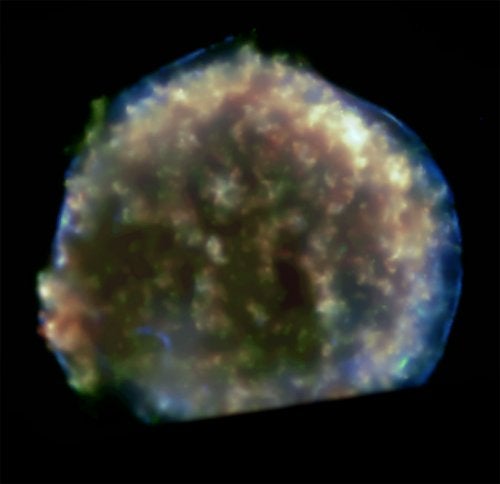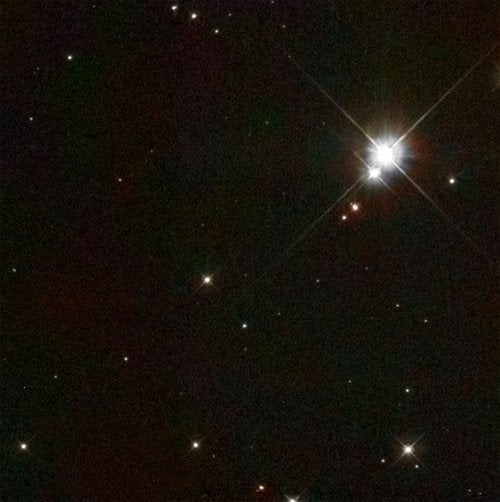An international team of astronomers has found a Sun-like star whipping through the wreckage of a star seen to explode in Cassiopeia 432 years ago. The star is racing at nearly 304,000 mph (490,000 km/h) through the remnant of Tycho’s supernova, which is named for the 16th-century Danish observer who recorded its brightness changes in unprecedented detail.
A team led by Pilar Ruiz-Lapuente of the University of Barcelona, Spain, published its discovery in the October 28 issue of the British science journal Nature. “There was no previous evidence pointing to any specific kind of companion star out of the many that had been proposed. Here we have identified a clear path: the feeding star is similar to our Sun, but slightly older,” Ruiz-Lapuente says. “The high speed of the star called our attention to it.” The runaway star is moving 3 times faster than other stars in the area.
Tycho Brahe and his colleagues didn’t know they were watching a star’s demise in 1572, but the sudden appearance of a brilliant new object was clearly important. The supernova helped Western astronomers finally abandon the idea that the heavens were immutable.
For Tycho, who would become one of the leading astronomers of the time, the story began on November 11, 1572. During a walk before dinner, he noticed “directly overhead, a certain strange star … flashing its light with a radiant gleam.” His candid account of the discovery gives us a sense of how radical an event this was to 16th-century astronomers.
Tycho’s meticulous record of the supernova’s changing brightness allowed modern astronomers to identify it as a Type Ia supernova — key players in the newest cosmological discoveries. The peak brightness among this supernova class is always very similar, which makes it an important “standard candle” for establishing distance in the far universe. As reliable distance markers, Type Ia supernovae help astronomers measure how cosmic expansion has changed over time, and so they are fundamental to understanding the behavior of dark energy, the unknown force that is accelerating the universe’s expansion.
Spectra obtained with the 4.2-meter William Herschel Telescope in La Palma, Canary Islands, and the 10-meter Keck Telescopes in Hawaii show the high-speed star is an aging version of our own Sun. In the binary systems thought to produce Type Ia supernovae, the pair’s more massive star ages faster and eventually becomes a white dwarf. When the slower-evolving companion star subsequently ages to the point when it swells in size, some of its matter spills onto the dwarf. Hydrogen accumulates until the dwarf reaches a critical-mass threshold, called the Chandrasekhar limit, when it explodes as a titanic nuclear bomb.
“Among the various systems containing white dwarfs that receive material from a solar-mass companion, some are believed to be viable progenitors of Type Ia supernovae, on theoretical grounds. A system called U Scorpii has a white dwarf and a star similar to the one found here,” Ruiz-Lapuente says. “These results would confirm that such binaries will end up in an explosion like the one observed by Tycho Brahe, but that would occur several hundreds of thousands of years from now.”











